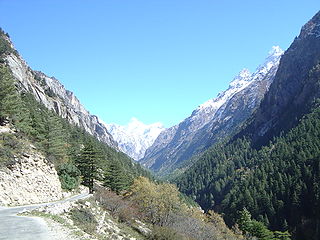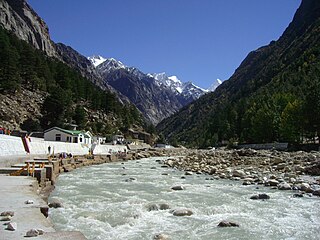
Gangotri is a town and a Nagar Panchayat (municipality) in Uttarkashi district in the state of Uttarakhand, India. It is 99 km from Uttarkashi, the main district headquarter. It is a Hindu pilgrim town on the banks of the river Bhagirathi – the origin of the river Ganges. The town is located on the Greater Himalayan Range, at a height of 3,100 metres (10,200 ft). According to popular Hindu legend, Goddess Ganga descended here when Lord Shiva released the mighty river from the locks of his hair.

The Bhāgīrathī is a turbulent Himalayan river in the Indian state of Uttarakhand, and one of the two headstreams of the Ganges, the major river of Northern India and the holy river of Hinduism. In the Hindu faith, mythology, and culture, the Bhagirathi is considered the source stream of the Ganges. However, in hydrology, the other headstream, Alaknanda, is considered the source stream on account of its great length and discharge. The Bhagirathi and Alaknanda join at Devprayag in Garhwal and are thereafter known as the Ganges.

Uttarkashi District is a district of Garhwal division of the Uttarakhand state in northern India, and has its headquarters at Uttarkashi city. It has six Tehsils namely Barkot, Dunda, Bhatwadi, Chinyalisaur, Purola and Mori.

Uttarkashi, meaning Kashi of the north, is a town located in Uttarkashi district in Uttarakhand, India. Uttarkashi town is headquarters of the district. Uttarkashi is also known as Somya Kashi. Uttarkashi is a religious place for spiritual and adventurous tourism. Uttarkashi town is also called as Shivnagri. The town has number of temples and ashrams. Uttarkashi is known for its religious people, weather, education.

Harsil, the Himalayan paradise, is a village, tourist hill station and army area located on the banks of the Bhagirathi River, on the way to Gangotri, a Hindu pilgrimage site in Uttarkashi district of the Indian state of Uttarakhand.
Bhotiyas are people of presumed Tibetan heritage that live along the Indo-Tibetan border in the upper reaches of the Great Himalayas, at elevations ranging from 6,500 feet (2,000 m) to 13,000 feet (4,000 m). In Uttarakhand, they inhabit seven river valleys, three in the Garhwal division and four in the Kumaon division. Their main traditional occupation used to be Indo-Tibetan trade, with limited amounts of agriculture and pastoralism. The customary Indo-Tibetan trade drastically stopped following the 1962 Sino-Indian war, and was resumed in the early 1990s under state-regulated mechanisms. These days, medicinal and aromatic plant collection is a major livelihood among this group, alongside by out-migration for education and jobs. Transhumance and pastoralism have drastically reduced in prevalence among this group too. They follow Hinduism and Buddhism and traditionally speak West Himalayish languages.

Mana is a village in the district of Chamoli in the Indian state of Uttarakhand, located at an altitude of 3,200 meters. It is located on the northern terminus of National Highway 7, Mana is the last village before the Mana Pass and is 26 kilometres from the border of India and Tibet The village is at a distance of about 3 km from the Hindu Pilgrimage Badrinath and the two places are culturally connected with each other.

Jad (Dzad), also known as Bhotia and Tchhongsa, is a language spoken by a community of about 300 in the states of Uttarakhand and Himachal Pradesh, in India. It is spoken in several villages, and the three major villages are Jadhang, Nelang and Pulam Sumda in the Harsil sub-division of the Uttarkashi District. Jad is closely related to the Lahuli–Spiti language, which is another Tibetic language. Jad is spoken alongside Garhwali and Hindi. Code switching between Jad and Garhwali is very common. The language borrows some vocabulary from both Hindi and Garhwali. It is primarily a spoken language.

Jadh Ganga, also called Jahnavi River is a tributary of Bhagirathi in Uttarakhand state of India.

Dhumku is a small hilly village which lies in Uttarkashi District of Uttarakhand state of India. Jadh Ganga, an important tributary of the Bhagirathi River, flows through this place. Some of the nearby villages are Nelang (Congsa), Jadhang (Sang) and Pulam Sumda, which all lie in the valley of the Jadh Ganga.

Bhaironghati is a small settlement at the juncture of the Jadh Ganga and Bhagirathi Rivers in the mountains of northern India. It is located in the Uttarkashi district of the Indian state Uttarakhand.

Nelang or Nilang is a river valley of Himalayas, with a small eponymous village, in Uttarkashi District of Uttarakhand state of India. It is close to disputed Sino-India Line of Actual Control (LAC), hence also claimed by China as part of Zanda County of Ngari Prefecture of Tibet.

Sang (Jadhang) is a small hilly village in Uttarkashi District, Uttarakhand, India, and claimed by Zanda County, Ngari Prefecture, Tibet, China. A tributary of the Jadh Ganga, itself an important tributary of the Bhagirathi River, flows through this place.
Chinyalisaur Airport, also known as Maa Ganga Airport and Dharasu Airport or Bharkot Airport, is located in Chinyalisaur of Uttarkashi district in the Indian state of Uttarakhand. The airport is situated 35 kilometres away from Uttarkashi and 85 kilometers from New Tehri on the banks of the Bhagirathi River.

The Indian Government is undertaking several initiatives to upgrade its aging railway infrastructure and enhance its quality of service. The Railway Ministry has announced plans to invest ₹5,400,000 crore (US$680 billion) to upgrade the railways by 2030. Upgrades include 100% electrification of railways, upgrading existing lines with more facilities and higher speeds, expansion of new lines, upgrading railway stations, introducing and eventually developing a large high-speed train network interconnecting major cities in different parts of India and development of various dedicated freight corridors to cut down cargo costs within the country.

Char Dham National Highway, is an under construction two-lane express National Highway with a minimum width of 10 metres in the Indian state of Uttarakhand. The under construction highway will complement the under-construction Char Dham Railway by connecting the four holy places in Uttarakhand states namely Badrinath, Kedarnath, Gangotri and Yamunotri. The project includes 900 km national highways which will connect whole of Uttarakhand state.
The Char Dham Railway, the Indian Railways's under construction twin railway lines, will complement the Char Dham Highway project by connecting the holiest places of Hinduism called Chota Char Dham, from the existing Doiwala railway station near Dehradun to Gangotri and Yamunotri via a fork at Uttarkashi and another set of twin rail links from the upcoming railway station at Karnaprayag to Kedarnath and Badrinath via a fork at Saikot. The line is also of strategic military importance and has been designated a national project.
Palar, is a village in Uttarkashi district of Uttarakhand state in India. Situated on the banks of Yamuna river and the terminating railway station on the Uttarkashi-Palar Yamunotri Railway route of Chota Char Dham Railway nearest to Yamunotri.

Border Personnel Meeting points are locations along the disputed Sino-Indian territories on Line of Actual Control (LAC) where the armies of both countries hold ceremonial and practical meetings to resolve border issues and improve relations. While border meetings have been held since the 1990s, the first formal Border Personnel Meeting point was established in 2013. There are five meeting points: two in the Indian Union Territory of Ladakh or India's Western (Northern) sector corresponding to China's Southern Xinjiang Military District of the Western Theater Command, one in Sikkim, and two in Arunachal Pradesh in India's Central and Eastern sectors corresponding to China's Tibet Military District.













